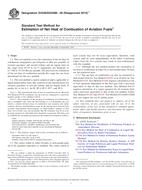We need your consent to use the individual data so that you can see information about your interests, among other things. Click "OK" to give your consent.
ASTM D3338/D3338M-09(2014)e1
Standard Test Method for Estimation of Net Heat of Combustion of Aviation Fuels (Includes all amendments And changes 7/14/2015).
Automatically translated name:
Standard Test Method for Estimation of Net Heat of Combustion of Aviation Fuels
STANDARD published on 1.5.2014
The information about the standard:
Designation standards: ASTM D3338/D3338M-09(2014)e1
Note: WITHDRAWN
Publication date standards: 1.5.2014
SKU: NS-23336
The number of pages: 4
Approximate weight : 12 g (0.03 lbs)
Country: American technical standard
Category: Technical standards ASTM
Annotation of standard text ASTM D3338/D3338M-09(2014)e1 :
Keywords:
aviation fuel, gross heat of combustion, heat energy, heat of combustion, heating tests, net heat of combustion, ICS Number Code 75.160.20 (Liquid fuels)
Additional information
| Significance and Use | ||||||||||||||||||||||||||||||||||
|
5.1 This test method is intended for use as a guide in cases where experimental determination of heat of combustion is not available and cannot be made conveniently and where an estimate is considered satisfactory. It is not intended as a substitute for experimental measurements of heat of combustion. Table 1 shows a summary for the range of each variable used in developing the correlation. The mean value and an estimate of its distribution about the mean, namely the standard deviation, is shown. This indicates, for example, that the mean density for all fuels used in developing the correlation was 779.3 kg/m3 and that two thirds of the samples had a density between 721.4 and 837.1 kg/m3, that is, plus or minus one standard deviation. The correlation is most accurate when the values of the variables used are within one standard deviation of the mean, but is useful up to two standard deviations of the mean. The use of this correlation may be applicable to other hydrocarbon distillates and pure hydrocarbons; however, only limited data on non-aviation fuels over the entire range of the variables were included in the correlation. Note 4: The procedures for the experimental determination of
the gross and net heats of combustion are described in Test Methods
D240 and D4809.
5.2 The calorimetric methods cited in Note 4 measure gross heat of combustion. However, net heat is used in aircraft calculations because all combustion products are in the gaseous state. This calculation method is based on net heat, but a correction is required for condensed sulfur compounds. |
||||||||||||||||||||||||||||||||||
| 1. Scope | ||||||||||||||||||||||||||||||||||
|
1.1 This test method covers the estimation of the net heat of combustion (megajoules per kilogram or [Btu per pound]) of aviation gasolines and aircraft turbine and jet engine fuels in the range from 40.19 to 44.73 megajoules per kilogram or [17 280 to 19 230 Btu per pound]. The precision for estimation of the net heat of combustion outside this range has not been determined for this test method. 1.2 This test method is purely empirical and is applicable to liquid hydrocarbon fuels that conform to the specifications for aviation gasolines or aircraft turbine and jet engine fuels of grades Jet A, Jet A-1, Jet B, JP-4, JP-5, JP-7, and JP-8. Note 1: The experimental data on heat of combustion from which
the Test Method D3338
correlation was devised was obtained by a precision method similar
to Test Method D4809.
Note 2: The estimation of the net heat of combustion of a
hydrocarbon fuel is justifiable only when the fuel belongs to a
well-defined class for which a relation between heat of combustion
and aromatic and sulfur contents, density, and distillation range
of the fuel has been derived from accurate experimental
measurements on representative samples of that class. Even in this
case, the possibility that the estimates may be in error by large
amounts for individual fuels should be recognized. The fuels used
to establish the correlation presented in this method are defined
as follows:
Note 3: The property ranges used in this correlation are as
follows:
1.3 The values stated in either SI units or inch-pound units are to be regarded separately as standard. The values stated in each system may not be exact equivalents; therefore, each system shall be used independently of the other. Combining values from the two systems may result in non-conformance with the standard. 1.3.1 Although the test method permits the calculation of net heat of combustion in either SI or inch-pound units, SI units are the preferred units. 1.3.2 The net heat of combustion can also be estimated in inch-pound units by Test Method D1405 or in SI units by Test Method D4529. Test Method D1405 requires calculation of one of four equations dependent on the fuel type with a precision equivalent to that of this test method. Test Method D4529 requires calculation of a single equation for all aviation fuels with a precision equivalent to that of this test method. Unlike Test Method D1405 and D4529, Test Method D3338/D3338M does not require the use of aniline point. 1.4 This standard does not purport to address all of the safety concerns, if any, associated with its use. It is the responsibility of the user of this standard to establish appropriate safety and health practices and determine the applicability of regulatory limitations prior to use. |
||||||||||||||||||||||||||||||||||
| 2. Referenced Documents | ||||||||||||||||||||||||||||||||||
|
We recommend:
Technical standards updating
Do you want to make sure you use only the valid technical standards?
We can offer you a solution which will provide you a monthly overview concerning the updating of standards which you use.
Would you like to know more? Look at this page.




 Cookies
Cookies
